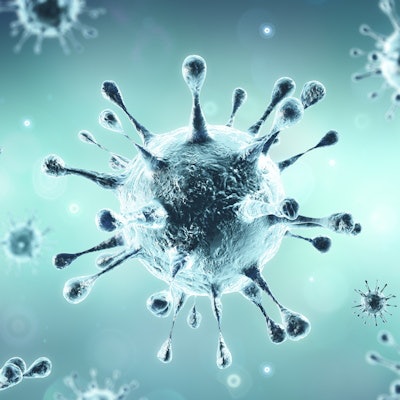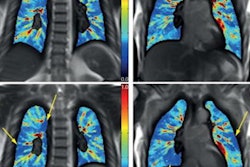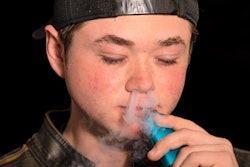
COVID-19 and electronic cigarette, or vaping, product use-associated lung injury (EVALI) share many features on CT, but the imaging modality's role in diagnosing the diseases has taken diverging paths, according to a March webinar hosted by the American Roentgen Ray Society.
"Both EVALI and COVID-19 cause lung injury, and both cause, as a result, organizing pneumonia," said Dr. Travis Henry, associate professor of cardiothoracic imaging at the University of California, San Francisco. "You may have individuals who vape present with fever and coughing -- and the question is: Is this vaping or is this related to COVID-19?"
The U.S. Centers for Disease Control and Prevention diagnostic criteria for EVALI include the presence of pulmonary infiltrate on chest x-ray or CT, but no specific imaging finding is mentioned, Henry noted. This is because EVALI triggers nonspecific findings that often overlap with those of other lung diseases, which parallels the current predicament with imaging COVID-19.
"So how can we determine which patient with lung injury has COVID-19 and which one has EVALI, or influenza A, or antisynthetase syndrome, etcetera?" he said. "You need to know what the clinical context is. We have no idea based on CT alone."
Yet certain CT patterns arise more consistently in cases of EVALI and COVID-19 that could help distinguish the two diseases, he noted.
For EVALI, the most prevalent CT features are organizing pneumonia, diffuse alveolar damage, diffuse alveolar hemorrhage, and centrilobular nodularity. The disease is usually characterized by low amounts of ground-glass opacity that gradually shift to more widespread, symmetric consolidation over time, with some subpleural sparing.
The predominant CT features of COVID-19 also include the presence of ground-glass opacity and indications of organizing pneumonia but the findings tend to maintain a peripheral distribution and bilateral involvement.
A wide range of other diseases involve a process on CT that could also be mistaken for COVID-19, emphasizing the need for "a test that has something specific about it, meaning a finding that is not present in individuals who don't have disease," said Dr. Constantine Raptis from the Mallinckrodt Institute of Radiology in St. Louis. "And that's the benefit of reverse transcription polymerase chain reaction (RT-PCR) testing that, in my opinion, we can't provide you with chest CT."
Research has thus far shown conflicting findings regarding the use of CT to diagnose COVID-19, with studies reporting sensitivity for the test ranging from 50% to 98%, depending on the guidelines followed.
Unlike for EVALI, the purpose of CT in COVID-19 is not necessarily to be able to differentiate it from other diseases, according to Henry and Raptis. Rather, clinicians should order CT for COVID-19 only to evaluate for potential complications and progression of disease.
"I think we can actually be looser with EVALI because the main drawback of [CT] imaging for EVALI patients is radiation dose, since EVALI is not a contagious disease," Raptis said. "There are much more important drawbacks to imaging suspected COVID-19 patients, including unnecessary exposure to staff and patients, shutting down scanners for sterilization, clustering patients in medical facilities, and giving a false sense of security."
The current reality is that whether the CT scan is positive or negative for COVID-19, the clinical management of these patients should remain the same. "The answer is not using CT as a surrogate, it's getting more RT-PCR tests," he said.
Still, in areas where COVID-19 is endemic, it's worth contacting ordering physicians to let them know that COVID-19 is a possibility so they can evaluate and manage the patient appropriately, Raptis continued. And it is essential for radiologists to be familiar with the CT features of viral pneumonia and lung damage because they are likely going to encounter COVID-19 in individuals who receive imaging for other reasons.
"If you want to be a great radiologist, learn what the many faces of lung damage are and you can tackle these diseases," he concluded.




















